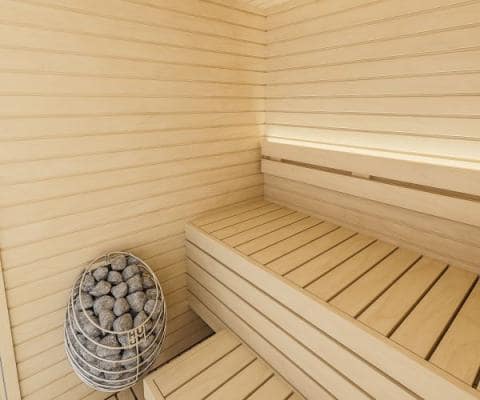Indicators on Traditional Sauna You Should Know
Wiki Article
The Best Guide To Traditional Sauna
Table of ContentsA Biased View of Traditional SaunaThe Buzz on Traditional SaunaThe Of Traditional SaunaThe 7-Second Trick For Traditional SaunaIndicators on Traditional Sauna You Need To Know
The majority of the weight shed in a sauna is water loss and is re-gained upon rehydrating. Nonetheless, undeniably sauna can be a fundamental part of a healthy weight management program. To consider the distinctions between standard and IR saunas, I will certainly divide these right into proven, academic, and made distinctions.Hence, the best factor in the saunawhich is at the ceiling directly above the sauna heateris usually in between 185 and 190 F. Claims that a typical sauna goes beyond 200 F is simply not true and not applicable for electric saunas sold in the US. The temperature for a far-infrared sauna is typically set between 120 and 140 F; nonetheless, unlike the conventional sauna, the goal in and IR room is not to attain a heat.
Due to the fact that of this, the temperature level distinction is nearly pointless, considering that excessive sweating leads to both sauna types, but the approach of warming the body is different. In an IR sauna the bather will really feel warm and will sweat profusely, but at a lot lower temperatures. Traditional Sauna. Therefore, if the objective is to invest longer amount of times in the sauna, the IR sauna is a great choice

The 2-Minute Rule for Traditional Sauna

When the heat is attained, the aspects cycle on and off to keep the heat. Traditional Sauna. Many standard sauna customers appreciate pouring water over the rocks to create steam to raise sauna humidity degrees. The advantages of pouring water over the rocks include: making the room a lot more comfy, dampening the nasal flows, and permitting the usage of aromatherapy by blending important oils with the water
In a far-infrared sauna, the warm front permeate the body to efficiently heat the body and raise the body core temperature. To achieve this increased temperature level, Far-infrared emitters produce infrared power which is close to the exact same wavelength as that which the body naturally emitsoften referred to as the "Vital Array" of 7 to 14 microns), so the power is well gotten by the body.
When the energy enters the body, it causes the body temperature to increase and ultimately results in sweat. In an infrared sauna it is necessary for the emitters/heaters to continue to be on virtually frequently. Given that there is no mass of rocks to maintain warm, the sauna will certainly cool down if the emitters shut down.
Traditional Sauna for Beginners
As mentioned over, the sauna bather in an infrared space wants to position himself before operating emitters to obtain maximum gain from the warmth. The heating time for the 2 rooms can be really various, depending upon how the areas are used. For a traditional sauna, a bather should allow 30-40 mins for the room to accomplish a desired temperature level and to appropriately pre-heat the rocks.A well created sauna will usually attain a temperature level of 150-160 F in concerning 30-40 minutes. For hotter temperatures, the area may require to warmth for a longer period.

Conventional saunas have a tendency to be bigger (for this reason utilize more power) than infrared saunas, although conventional saunas are certainly available in one and two individual dimensions too. For a two-person typical sauna, 5x6 or 5x7 dimension is most prominent. The top bench can comfortably seat 2 or 3 people and is also long sufficient to rest during the sauna session.
The 25-Second Trick For Traditional Sauna
The ordinary expense per kWH of electricity in the U.S. is about $0.11 - Traditional Sauna, so a 4.5 kW heating system will certainly cost about $.50 to compete one hour, if the heating unit runs continually for one hour. Commonly a sauna heating unit will compete 75% of the first hour and 50% of subsequent hours on given that the aspects cycle once the established temperature is accomplishedA 2 person far-infrared space is generally literally smaller than a conventional sauna, usually about 4' x 4' or smaller. The IR heater is commonly 1.5-1.7 kW using a 120 volt have a peek here 15 amp plug-in solution. Given that the room can be utilized quicker than a sauna room, we will presume the space is made use of for to of an hour consisting of warm up time.
Finally, there is a rarely gone over distinction in the social experience in between the two areas. While our society has actually lost some of the social benefit of the conventional sauna experience, it can be very socially gratifying. From household time in the sauna, to heart-felt discussions with better halves, to sauna partiesthe typical sauna experience can result in intimate interacting socially.
Indicators on Traditional Sauna You Need To Know
Most higher end infrared areas include colored light treatment, stereo and full-glass fronts. The size of most spaces enable 2 people to easily use the room, while some layouts may permit a third or fourth person to make use of the space. Custom-made infrared rooms are also readily available, with area sizes readily available up to 7' x 8' x 7' high.Report this wiki page